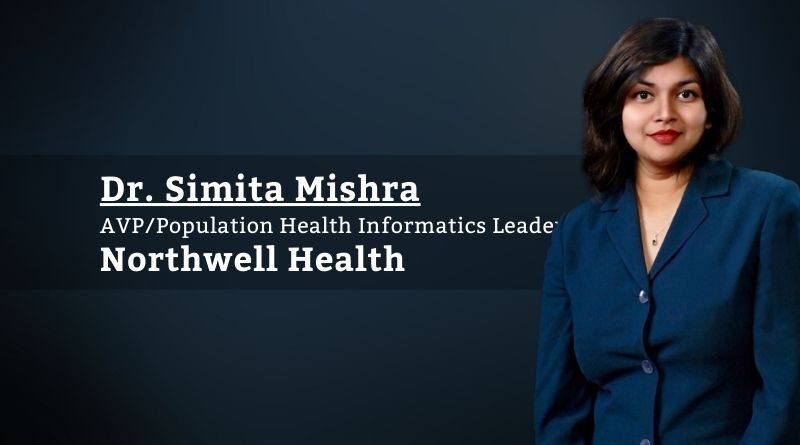Healthcare innovations augmented by a pandemic
By Dr. Simita Mishra, AVP/Population Health Informatics Leader and Raman Vig, Community Remote Care Program Manager, Northwell Health
The mission of the Northwell Population Health Informatics team is to improve population health and community outcomes through informatics and underlying technology. The COVID-19 pandemic expedited the need for some of this technology such as digital remote care and drew more focus to population health initiatives. While it shouldn’t take a pandemic to raise the importance of population health in the minds of the general public, that is exactly what happened in these last two years. The pandemic has allowed this focus on population health to be consistent for a significant amount of time, widening a pathway for us to learn through numerous areas of concentration Including the increase in utilization of video-based technology, the CMS Hospital at Home waiver, and Remote Therapeutic Monitoring.
One such area of focus for us was the rapid expansion of telehealth services at Northwell. While telehealth became a commodity during the COVID-19 Public Health Emergency, we have been looking into it for many years. Northwell went from having 200 clinicians on its telehealth platform prior to the outbreak, to more than 8,000 clinicians, nurses, and office managers in 2020. From April 1, 2020 to April 1, 2021, the health system performed nearly 500,000 telehealth visits. With this expansion of telehealth services, we are now looking to grow video-based telehealth into remote monitoring-based telehealth. There is no doubt the pandemic assisted in speeding up this process.
The COVID-19 pandemic expedited the planning, implementation, and adoption of numerous digital initiatives including the expansion of video-based telehealth, the proliferation of the Hospital at Home program, and the establishment of remote therapeutic monitoring.
This brings us to another area of focus: remote care. Our areas of study around remote care include the preferences of our patients, consumer reasons for certain visits, and the needs of specific populations. One example of these needs would be the social issues impacting the use of remote care and how remote care may potentially assist vulnerable populations who cannot afford to travel to seek the healthcare they need. Prior to the pandemic, remote care was sparsely used. Some populations preferred remote care, and some required it due to barriers to mobility. However, most patients would by default go in for an in-person visit. With COVID-19, this idea was flipped on its head. Now, if it is an emergency, then you can come into the office. Otherwise, to avoid contact during the pandemic, remote care would be the default option for all. We expect patients to be driven by individual preferences regarding the type of visits they wish to have moving forward.
The pandemic also helped raise the need for more comprehensive remote care options for non-COVID related ailments. At the height of the COVID-19 Public Health Emergency in 2020, patients had to be turned away from hospitals due to a lack of available beds. Some normally hospitalized cases couldn’t even make it through the hospital door. At the same time, other patients who sought care were too afraid to even set foot outside their homes. We needed to break the walls of these inpatient facilities and figure out a way to expand access to high-quality inpatient care out to the community. CMS first provided the opportunity by establishing the Hospitals Without Walls program in March 2020, and then the Acute Hospital Care at Home program in November 2020.These changes coupled with the success of hospital at home initiatives at other large health systems gave us an opportunity to align a population health benefit to the financial incentives in current inpatient contracts. Now, we have the opportunity to provide the same level of care and receive the same level of reimbursement. At the same time, eligible patients normally admitted into an inpatient ward could be treated in a remote hospital unit in the comfort of their own homes.
Another area of focus for us related to remote care that was elevated by the pandemic would be the expansion and availability of remote therapeutic monitoring. While CMS had previously established reimbursement rules for remote patient monitoring (RPM), it has now introduced reimbursement rules for 2022 related to remote therapeutic monitoring. Where RPM allowed reimbursement for the monitoring of physiologic data only, remote therapeutic monitoring allows for the use of medical devices that collect non-physiologic data such as medication adherence and pain level. In addition, where RPM has a limited subset of clinicians that can bill for the service, the intention of remote therapeutic monitoring is to expand this service to a larger swath of clinicians such as nurse practitioners and physical therapists. Finally, where RPM requires the medical device to automatically record and upload patient physiologic data, remote therapeutic monitoring allows for self-reported data to be part of the non-physiologic data collected.
One final area of focus for our team that was spotlighted by the pandemic has been social determinants of health. While a person’s environment has always affected their health outcomes and risks, it was the pandemic that showed how truly urgent a priority it is to incorporate social data with clinical data to support care decisions and address social justice. During the pandemic, Northwell won a Phase 1 award in the Administration for Community Living’s Social Care Referrals Challenge competition by working with CBOs to aggregate referral data from multiple care settings and eliminate duplicative workflows by streamlining the referral process for Northwell Health’s care teams to create referrals, CBOs to receive the referrals, and for the referral results to be shared back with Northwell Health.
The COVID-19 pandemic expedited the planning, implementation, and adoption of numerous digital initiatives including the expansion of video-based telehealth, the proliferation of the Hospital at Home program, and the establishment of remote therapeutic monitoring. We are looking forward to learning how these technologies and others move the needle with respect to improving population health outcomes and reporting on a successful digital transformation. We also look forward to creating blueprints for scalability and sustainability of these initiatives and understanding the opportunities for improvements to move the needle even faster with a higher value for our populations in the future.



